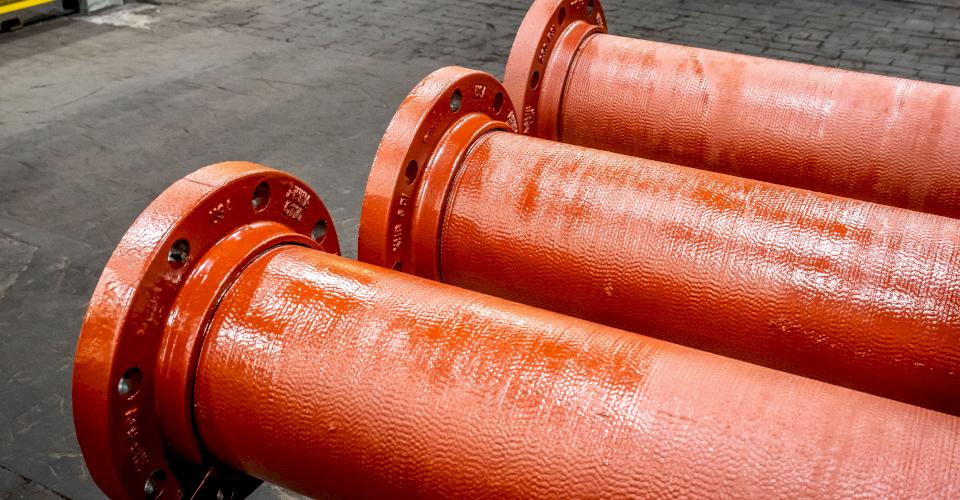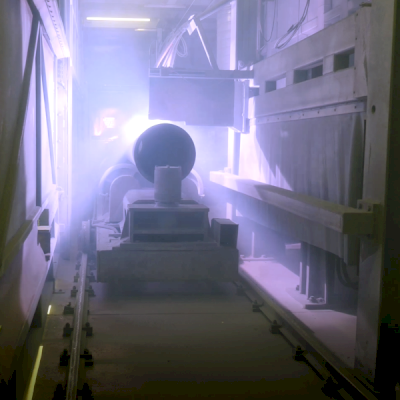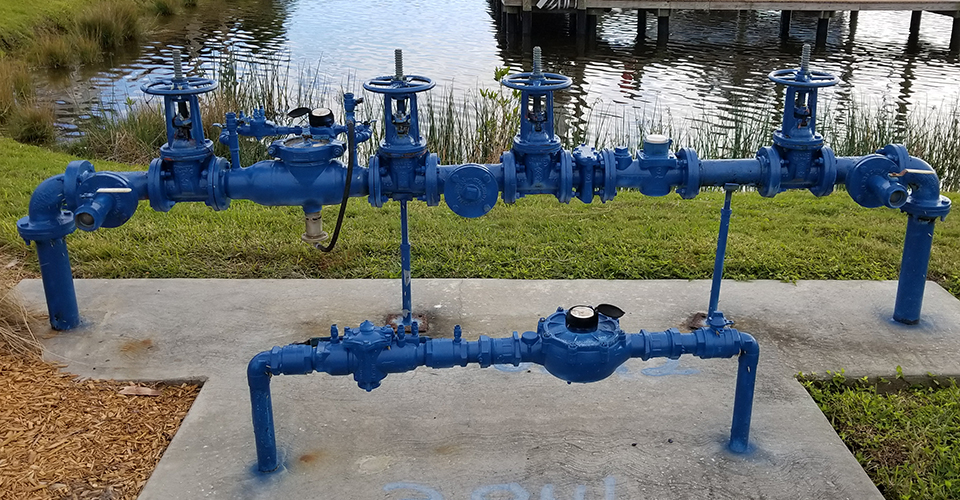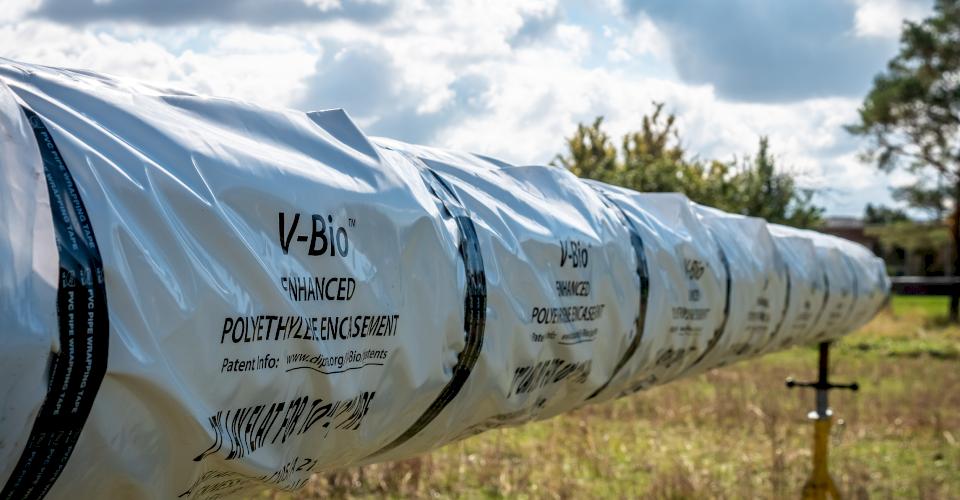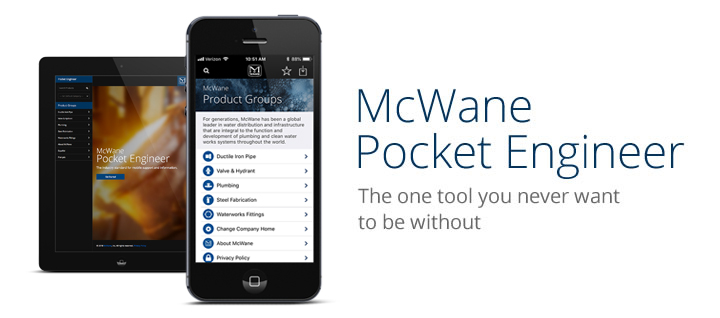Can McWane Ductile provide bonded coatings? This is a good question recently posed and more frequently asked due to a greater recognition of potential corrosive environments. To correctly address this question, some other questions need to be answered first.
To oversimplify the issue, an indirect answer of "it depends" can be given. Since this obviously doesn’t really satisfy, we need to have a slightly deeper discussion including defining some key parameters or answering some basic questions:
- What is a bonded coating?
- What bonded coatings are available from McWane Ductile?
- Why would I need or use a bonded coating?
- What alternatives are there to using a bonded coating?
What is a bonded coating?
A bonded coating is generally defined in the pipe world as a coating that is mechanically or chemically attached to the pipe’s outside surface, ostensibly to provide some level of corrosion resistance or protection.
Essentially, any type of paint on a pipe would meet a loose definition of a bonded coating.
Some further definition would include other requirements such as whether the coating provides dielectric benefit(s).
Using these definitions, McWane Ductile can, in fact, provide three bonded coatings for ductile iron pipe – zinc, tape wrapping (commonly referred to by the trade name Pritec®), and Ceramawrap®, as manufactured by Induron®.
What bonded coatings are available from McWane Ductile?
McWane Ductile offers a few bonded coatings, and for the latest offerings, contact your local McWane Ductile sales representative.
- Zinc coating is available from all McWane Ductile manufacturing plants. McWane Ductile’s zinc is applied and furnished in accordance with ISO 8179-1:2017 at a rate of 200 g/m2 (grams/square meter) and furnished with a topcoat.
- Pritec® is a two-layer anti-corrosion wrap for pipes 3-to 48-inches in diameter. It consists of a butyl rubber adhesive layer that reliably bonds the durable polyethylene topcoat to the pipe. Pritec® has decades of proven service in the gas and oil fields, as well as water and sewer utilities. This system, applied by a licensed applicator, has installation and handling requirements that any prospective specifier or user should become familiar with prior to specifying or purchasing. Product information can be found at http://www.libertycoating.com/_assets/docs/Pritec_Product_Data_Sheet.pdf.
- Ceramawrap® can be a confusing moniker in that it is not a “wrap” per say (like Pritec®) but an epoxy from the same compositional family as Protecto 401TM, the longest proven-in-service ceramic-enhanced epoxy lining for ductile iron pipe and fittings. The word “wrap” is in the name to mentally distinguish it as an external coating, as opposed to an interior lining. Ceramawrap® is essentially Protecto 401TM for the outside of a pipe or fitting.
NOTE: Another type of bonded, or protective coating would be Fusion Bonded Epoxy (FBE). Fusion Bonded Epoxy is a powder coating that can be applied to appurtenances such as valves, hydrants or fittings.
Why would I need or use a bonded coating?
There are only a few reasons to use a bonded coating:
- Using the basic definition; to include a paint and for visibly exposed piping systems, cosmetics may have a higher level of priority than pipe being buried in the ground and out of site. This is common in treatment plants, pumping stations, and above ground installations such as warm climate backflow prevention and fire protection installations.
- Other elevated pipe installations, such as a bridge or aerial crossings may also have a cosmetic need for a bonded coating. These installations, being exposed, could exhibit some surface oxidation, which while cosmetically unappealing, do not have a real impact on pipe service life.
- In buried applications, a severely corrosive environment might suggest the use of cathodic protection (CP) for corrosion resistance. These severely corrosive environments are generally rare but to discount them would result in a very short pipeline service life. A review of the corrosive soil identification system can be found in AWWA C-105 Polyethylene Encasement for Ductile Iron Pipe and the CorrPro/DIPRA Design Decision Model (DDM).
- A decision to use cathodic protection should only be made after consultations with a qualified corrosion professional such as McWane Ductile’s NACE Certified Engineers.
What alternatives are there to using a bonded coating?
Alternatives to bonded coatings depend on the need and purpose of using the bonded coating in the first place. The best course of action for a specific application would be to contact McWane Ductile’s NACE Certified Engineers. In many cases, however, there are some simple alternatives to bonded coatings.
- V-Bio polyethylene encasement has been shown to be a superior corrosion protection system on very corrosive environments through testing in various test sites. Also, McWane Ductile has an independent, ongoing V-Bio performance study in conjunction with several utilities scattered throughout the United States. This research is showing the effectiveness of V-Bio Polyethylene Encasement and, in fact, has shown zero corrosion. When used in conjunction with zinc coating and with or without cathodic protection, there has been zero to insignificant change in corrosion performance. Furthermore, V-Bio Polyethylene Encasement and its predecessors have been shown to work well with cathodic protection due to the encasement’s inherent dielectric properties.
In conclusion, bonded coating can be obtained from McWane Ductile on a limited basis depending on the purpose and need. To best determine what coating or system is appropriate for your installation or project, it’s best to take advantage of the free services of McWane Ductile’s Product and Sales Engineers.
Need assistance with your water infrastructure project?
McWane Ductile offers multiple services for our customers extending far beyond manufacturing ductile iron pipe. From design to installation, we take great pride in providing education and assistance to water professionals throughout the water ans wastewater industry.
I encourage you to call your local sales representative for a live presentation on all our products or check out our digital offerings:
References
AWWA C-105 “Polyethylene Encasement for Ductile Iron Pipe”
CORRPR, “Ductile Iron Pipe V-Bio ® Enhanced Polyethylene Encasement and Zinc Metalizing – Corrosion Control Research Project Report”
Michael Britch, P.E., “Tualatin Valley Water District’s Systematic Approach to Developing New Standards to Address Aging Pipeline Infrastructure”
“Bonded Coatings vs Polyethylene Encasement"
Richard W. Bands, Lyle M. Barnard, A. Michael Horton, and Gene L. Oliver, “Corrosion and corrosion control of iron pipe: 75 years of research”

